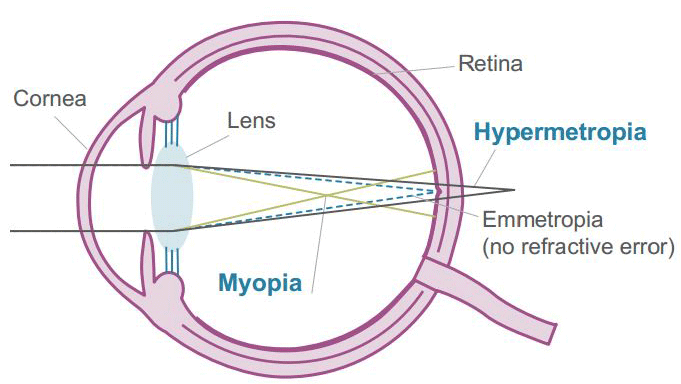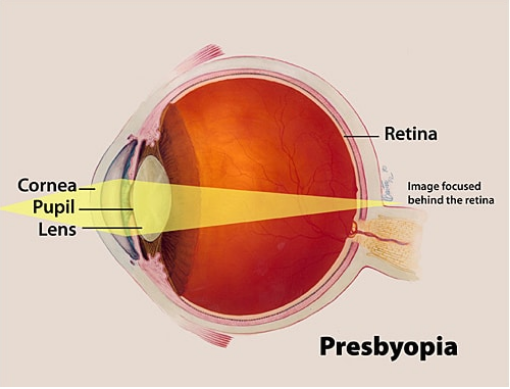
Myopia also referred to as Nearsightedness is a common vision in which you can see objects near to you clearly, but objects farther away are blurry. It occurs when the shape of the eyes causes light rays to bend (refract) incorrectly, focusing image in front of the retina instead of at the center of retina. Symptoms of Myopia may include:
- Blurry vision when looking at distant objects.
- Headaches caused by eyestrain.
- The need to squint or partially close the eyelids to see clearly.
- Excessive blinking.

Hypermetropia also referred to as long-sightedness or farsightedness, is a common eye condition whereby nearby objects appear blurred, but your vision is clearer when looking at things further away. Usually, the degree of farsightedness influences focusing ability. Severe farsightedness may make to see clearly only objects a great distant away whereas a person with mild farsightedness may be able to clearly see objects that are closer. Symptoms of hypermetropia include:
- Near objects appear blurry.
- Eye strain, including burning eyes and aching in or around the eyes.
- General eye discomfort.

Presbyopia is the gradual loss of eye’s ability to focus on nearby objects. Usually, presbyopia is noticeable in early to mid-40s and continues to worsen until around age 65. Common symptoms include:
- A tendency to hold reading material farther away to make the letters clearer.
- Eyestrain or headaches after reading or doing close-up work.
- Blurred vision at normal reading distance.
The Difference: Myopia Vs. Hepermetropia (Hyperopia) Vs Presbyopia
Description
Myopia: Myopia is a type of refractive error whereby nearby objects appear normal and clear whereas distant objects appear blurry. Myopia is commonly referred to as Short–sightedness.
Hypermetropia: Hypermetropia also referred to as Hyperopia is a refractive error in which faraway objects appear clear and normal than objects that are very close. Hypermetropia is commonly referred to as long sightedness.
Presbyopia: Presbyopia is the gradual loss of the eye’s ability to focus on nearby objects as a natural part of the aging process.
Image Formation
Myopia: When a person is having myopia, the object image is formed in front of the retina.
Hypermetropia: When a person is having hypermetropia, the object image is formed beyond retina.
Presbyopia: When a person is having Presbyopia, the object image is formed beyond retina.
Cause
Myopia: Myopia occurs when the eyeball is very long (gets elongated), this results in reduction in focal length of the eye lens and therefore the incoming light is diverted from focusing straight on the retina.
Hypermetropia: Hypermetropia occurs when the eyeball is very short (gets flattened), this results in increase in focal length of the eye lens and therefore incoming light is diverted from focusing straight on the retina.
Presbyopia: Presbyopia is due to hardening of the lens of the eye causing the eye to focus light behind rather than on the retina when looking at close objects.
Symptoms
Myopia: The symptoms of myopia include tired and strained eyes, headache, and frowning, squinting and blurred vision.
Hypermetropia: The symptoms of hypermetropia include squinting to see better, blurred vision, headaches, lazy and strained eyes.
Presbyopia: Symptoms of Presbyopia include difficulty reading small print, having to hold reading material farther away, headaches and eyestrains.
Risk Factors
Myopia: Genetics, ethnic attributes and environmental exposures like sunlight.
Hypermetropia: Birth disorder, short eyeball, high blood sugar, weak functioning of ciliary muscles and problems with the blood vessels in the eye retina.
Presbyopia: Age is the main risk factor of presbyopia. Other risk factors include eye trauma, poor blood circulation in the eye, hypermetropia, diabetes and multiple sclerosis.
Diagnosis
Myopia: Myopia is diagnosed by carrying out tests such as visual acuity, biometry, examination of eyeballs, eye lids and cornea, extra ocular muscle movement, slit lamp examination and fundoscopy.
Hypermetropia: Diagnosis of hypermetropia is almost the same with Myopia as it is based on the symptoms and clinical signs observed.
Presbyopia: Presbyopia is diagnosed during routine, comprehensive eye exams that test the ability to see both near and distant objects.
Treatment
Myopia: Myopia can be treated by use of concave lens eye glasses or corrective eye surgery.
Hypermetropia: Hypermetropia can be treated by use of convex lens eye glasses or corrective eye surgery.
Presbyopia: There is no cure for presbyopia, however, treatment for the condition consists of wearing eyeglasses or contact lenses. Several types of eyeglasses are available, including: Reading glasses, bifocals and trifocals.
Complications
Myopia: Myopia increases the risk of cataract and glaucoma, gradual loss of sight and retinal detachment.
Hypermetropia: Hypermetropia rarely has complication; however complication such as amblyopia and strabismus may arise. Strabismus is a condition whereby a person cannot use both eyes with coordination whereas amblyopia is a childhood disease in which vision of one eye is affected.
Presbyopia: Presbyopia can have complications such as astigmatism, which is an imperfection in the curvature of the cornea that causes blurred vision. Other complication may include anisometropia, cornea ectasia and haze among others.
Difference Between Myopia, Hypermetropia And Presbyopia In Tabular Form
| BASIS OF COMPARISON | MYOPIA | HYPERMETROPIA | PRESBYOPIA |
| Description | Myopia is a type of refractive error whereby nearby objects appear normal and clear whereas distant objects appear blurry. | Hypermetropia also referred to as Hyperopia is a refractive error in which faraway objects appear clear and normal than objects that are very close. | Presbyopia is the gradual loss of the eye’s ability to focus on nearby objects as a natural part of the aging process. |
| Image Formation | The object image is formed in front of the retina. | The object image is formed beyond retina. | The object image is formed beyond retina. |
| Cause | Occurs when the eyeball is very long (gets elongated), this results in reduction in focal length of the eye lens and therefore the incoming light is diverted from focusing straight on the retina. | Occurs when the eyeball is very short (gets flattened), this results in increase in focal length of the eye lens and therefore incoming light is diverted from focusing straight on the retina. | Due to hardening of the lens of the eye causing the eye to focus light behind rather than on the retina when looking at close objects. |
| Symptoms | Symptoms include tired and strained eyes, headache, and frowning, squinting and blurred vision. | Symptoms include squinting to see better, blurred vision, headaches, lazy and strained eyes. | Symptoms include difficulty reading small print, having to hold reading material farther away, headaches and eyestrains. |
| Risk Factors | Genetics, ethnic attributes and environmental exposures like sunlight. | Birth disorder, short eyeball, high blood sugar, weak functioning of ciliary muscles and problems with the blood vessels in the eye retina. | Age, eye trauma, poor blood circulation in the eye, hypermetropia, diabetes and multiple sclerosis. |
| Diagnosis | It is diagnosed by carrying out tests such as visual acuity, biometry, examination of eyeballs, eye lids and cornea, extra ocular muscle movement, slit lamp examination and fundoscopy. | Diagnosis is almost the same with Myopia as it is based on the symptoms and clinical signs observed. | It is diagnosed during routine, comprehensive eye exams that test the ability to see both near and distant objects. |
| Treatment | It can be treated by use of concave lens eye glasses or corrective eye surgery. | It can be treated by use of convex lens eye glasses or corrective eye surgery. | There is no cure for presbyopia, however, treatment for the condition consists of wearing eyeglasses or contact lenses. |
| Complication | It increases the risk of cataract and glaucoma, gradual loss of sight and retinal detachment. | It rarely has complication; however complication such as amblyopia and strabismus may arise. | It can have complications such as astigmatism, which is an imperfection in the curvature of the cornea that causes blurred vision. |